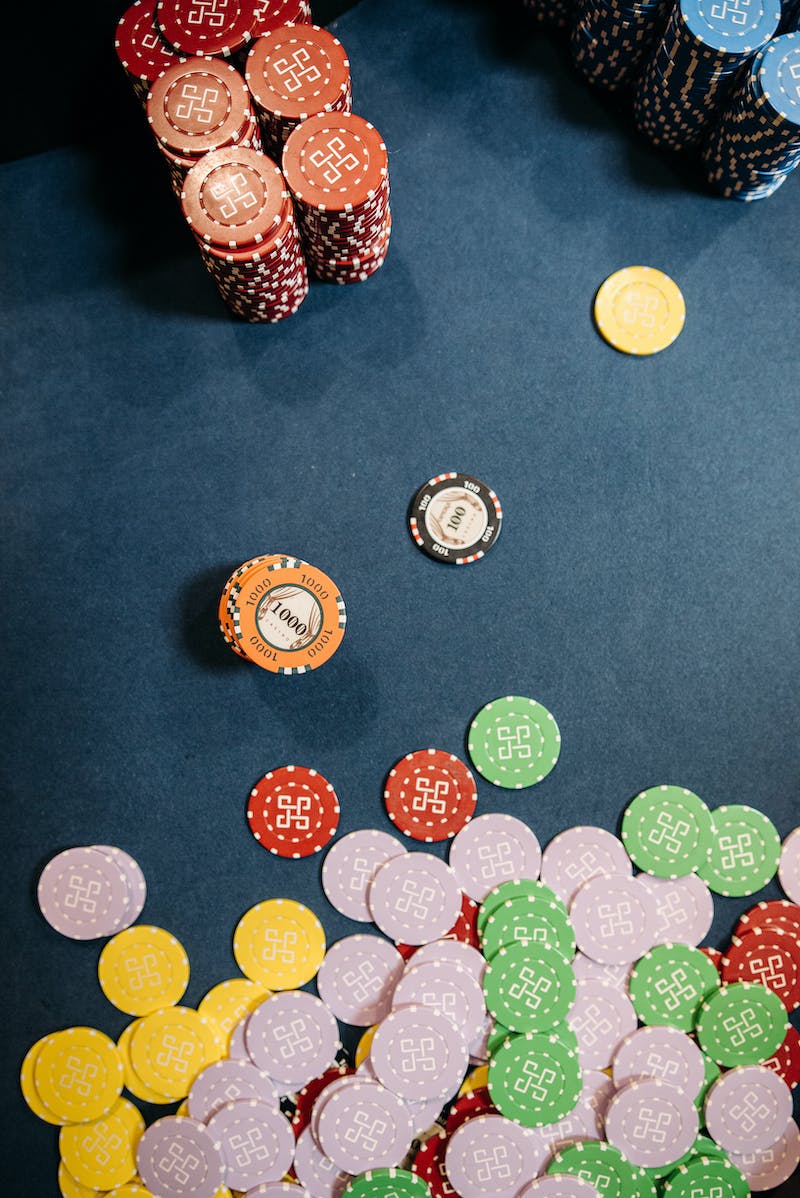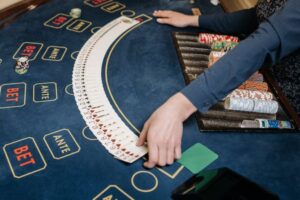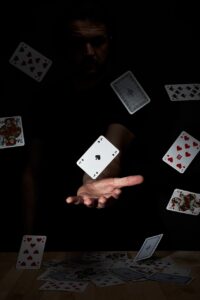The Poker Faceoff: Bluffing and Semi-Bluffing Your Way to Tournament Triumph is a comprehensive guide that delves into the art of bluffing and semi-bluffing in poker tournaments. This book explores the strategies, techniques, and psychological aspects involved in successfully executing these deceptive moves to gain an advantage over opponents. Whether you’re a beginner looking to understand the basics or an experienced player aiming to refine your skills, this book provides valuable insights and practical advice to help you master the art of bluffing and semi-bluffing in poker tournaments.
The Art of Bluffing in Poker Tournaments: Strategies for Success
Bluffing is a delicate dance, requiring a keen understanding of the game and the players at the table. It is not simply a matter of randomly throwing out bets and hoping for the best. Successful bluffing requires careful observation and analysis of your opponents’ behavior, as well as a deep understanding of the odds and probabilities involved.
One of the most effective bluffing strategies in poker tournaments is the semi-bluff. Unlike a pure bluff, where you have no chance of winning the hand if your opponents call your bet, a semi-bluff involves betting with a hand that has the potential to improve in later rounds. By doing so, you not only have a chance of winning the pot immediately but also the opportunity to hit a strong hand and win even more.
To execute a successful semi-bluff, you must first assess the strength of your hand and the likelihood of it improving. If you have a drawing hand, such as a flush or straight draw, and the odds are in your favor, it may be a good time to make a semi-bluff. By betting confidently, you can put pressure on your opponents and force them to make difficult decisions.
However, it is important to remember that semi-bluffing is not without risks. If your opponents call your bet and you fail to improve your hand, you may find yourself in a difficult position. This is why it is crucial to carefully consider the potential outcomes before making a semi-bluff. It is a calculated risk that requires a balance between aggression and caution.
In addition to the semi-bluff, there are several other bluffing strategies that can be employed in poker tournaments. One such strategy is the continuation bet, where a player who raised before the flop continues to bet on the flop, regardless of whether their hand improved or not. This can be an effective way to maintain control of the hand and keep your opponents guessing.
Another bluffing strategy is the overbet, where a player makes a disproportionately large bet in an attempt to intimidate their opponents. This can be particularly effective when used sparingly and against players who are more risk-averse. However, it is important to use this strategy judiciously, as overbetting too frequently can quickly erode your chip stack.
Ultimately, the key to successful bluffing in poker tournaments is adaptability. Every hand is unique, and the strategies that work in one situation may not work in another. It is important to constantly assess the dynamics at the table, adjust your strategy accordingly, and be prepared to switch gears when necessary.
In conclusion, bluffing is an essential skill in poker tournaments, and mastering the art of deception can greatly increase your chances of success. Whether it is through a well-executed semi-bluff, a continuation bet, or an overbet, bluffing allows you to control the narrative of the hand and keep your opponents on their toes. However, it is important to remember that bluffing is not a foolproof strategy and should be used judiciously. With practice and experience, you can develop the instincts and intuition necessary to bluff your way to tournament triumph.
Mastering the Semi-Bluff: A Powerful Weapon in Poker Tournaments
Poker tournaments are high-stakes battles of wits, where players must rely on their skills and strategies to outsmart their opponents. Bluffing is a well-known tactic in poker, but there is another technique that can be just as effective: the semi-bluff. Mastering the art of the semi-bluff can give players a powerful weapon to use in poker tournaments.
A semi-bluff is a bet or raise made with a hand that is not yet strong enough to win the pot, but has the potential to improve. It is a strategic move that combines elements of both bluffing and value betting. By semi-bluffing, players can put pressure on their opponents and potentially win the pot without having the best hand.
One of the key advantages of the semi-bluff is that it allows players to win pots in two ways. If their opponents fold, they win the pot immediately. If their opponents call, they still have a chance to improve their hand and win the pot at showdown. This dual potential for success makes the semi-bluff a valuable tool in a player’s arsenal.
To execute a successful semi-bluff, players must carefully choose their timing and target. It is important to semi-bluff when there is a reasonable chance of improving the hand. For example, if a player holds a flush draw, they have a good chance of hitting their flush with two cards to come. This gives them a strong semi-bluffing opportunity.
Another crucial aspect of the semi-bluff is reading the opponents. It is essential to have a good understanding of their playing style and tendencies. If a player knows that their opponent is likely to fold to aggression, a well-timed semi-bluff can force them to fold a better hand. On the other hand, if an opponent is known for calling down with weak hands, a semi-bluff may not be as effective.
The semi-bluff can also be used as a tool for deception. By occasionally semi-bluffing with strong hands, players can create an unpredictable image at the table. This can make it difficult for opponents to put them on a hand and make accurate decisions. The element of surprise can be a powerful weapon in poker tournaments.
However, it is important to note that the semi-bluff is not a strategy that should be used recklessly. It requires careful consideration and calculation. Players must be aware of the risks involved and be prepared to handle the consequences if their semi-bluff fails. It is crucial to have a backup plan and be able to adjust the strategy accordingly.
In conclusion, mastering the semi-bluff is a powerful weapon in poker tournaments. It allows players to win pots in two ways and puts pressure on opponents. Timing, target selection, and reading opponents are key factors in executing a successful semi-bluff. However, it is important to use this strategy wisely and be prepared for the potential risks. With practice and experience, players can add the semi-bluff to their arsenal and increase their chances of tournament triumph.
Psychological Tactics in Poker: Understanding the Poker Faceoff
The game of poker is not just about the cards you hold in your hand; it’s also about the mind games you play with your opponents. One of the most effective psychological tactics in poker is bluffing. Bluffing is the art of making your opponents believe that you have a stronger hand than you actually do. It’s a risky move, but when executed correctly, it can lead to a big payoff.
Bluffing requires a strong poker face. A poker face is a blank expression that gives nothing away about the player’s hand. It’s essential to maintain a poker face throughout the game, regardless of whether you have a strong hand or not. If your opponents can read your emotions, they will be able to make better decisions and potentially exploit your weaknesses.
To bluff successfully, you need to carefully observe your opponents and their betting patterns. Look for signs of weakness or hesitation. If a player hesitates before betting, it could be a sign that they have a weak hand. Use this information to your advantage and make a bold move. By betting aggressively, you can force your opponents to fold and win the pot without having the best hand.
However, bluffing is not without its risks. If your opponents see through your bluff, they may call your bet and expose your weak hand. This can be embarrassing and costly. Therefore, it’s important to choose your bluffing opportunities wisely. Bluffing too often can make you predictable and easy to exploit. It’s a delicate balance between taking calculated risks and playing it safe.
Another psychological tactic in poker is semi-bluffing. Semi-bluffing is similar to bluffing, but with a slight twist. Instead of having a completely weak hand, you have a hand that has the potential to improve. By semi-bluffing, you can put pressure on your opponents and increase your chances of winning the pot.
Semi-bluffing is particularly effective when you have a drawing hand, such as a flush or a straight draw. By betting or raising, you can make your opponents believe that you have a strong hand, forcing them to fold or call with weaker hands. If you hit your draw on a later street, you can then make a strong bet and potentially win a big pot.
Like bluffing, semi-bluffing requires careful observation and timing. You need to assess the strength of your hand and the likelihood of hitting your draw. If the odds are in your favor, go for it. But if the odds are against you, it’s better to fold and wait for a better opportunity.
In conclusion, psychological tactics play a crucial role in the game of poker. Bluffing and semi-bluffing are powerful tools that can help you win pots even when you don’t have the best hand. However, they require skill, observation, and timing. It’s important to maintain a poker face, carefully observe your opponents, and choose your bluffing opportunities wisely. With practice and experience, you can master the art of the poker faceoff and increase your chances of tournament triumph.
The Importance of Reading Opponents in Poker Tournaments
When it comes to poker, reading opponents is like peering into their souls. It involves observing their body language, facial expressions, and betting patterns to gain insights into their hand strength and potential strategies. A skilled player can pick up on subtle cues that reveal whether an opponent is bluffing or holding a strong hand. This information is invaluable as it allows players to adjust their own strategies accordingly.
One of the most common ways to read opponents is by observing their body language. A player who is confident and relaxed may indicate a strong hand, while someone who is fidgety or avoids eye contact might be bluffing. These non-verbal cues can provide valuable information that can be used to make calculated decisions during the game.
Facial expressions also play a significant role in reading opponents. A sudden twitch of the eyebrow or a slight smile can reveal excitement or nervousness, indicating the strength or weakness of a hand. However, it is important to note that some players are skilled at maintaining a poker face, making it more challenging to read their intentions solely based on their facial expressions.
Betting patterns are another crucial aspect of reading opponents. Observing how an opponent bets throughout the game can provide insights into their hand strength. For example, a player who consistently raises pre-flop may have a strong hand, while someone who frequently checks or calls might be playing cautiously with a weaker hand. By paying close attention to these patterns, players can make informed decisions about whether to fold, call, or raise.
In addition to reading opponents, players can also employ the strategy of bluffing to deceive their opponents. Bluffing involves making aggressive bets or raises with a weak hand to convince opponents that you have a strong hand. This can be a powerful tool when used strategically, as it can force opponents to fold stronger hands, giving the bluffer an advantage.
However, bluffing is not without risks. Skilled opponents can see through bluffs and exploit them, leading to significant losses. This is where the concept of semi-bluffing comes into play. Semi-bluffing involves making aggressive bets or raises with a hand that has the potential to improve in later rounds. By semi-bluffing, players can put pressure on opponents while still having a chance to win the hand if their draw comes through.
In conclusion, reading opponents is a crucial skill in poker tournaments that can make the difference between triumph and defeat. By observing body language, facial expressions, and betting patterns, players can gain valuable insights into their opponents’ intentions and adjust their strategies accordingly. Additionally, the strategic use of bluffing and semi-bluffing can further enhance a player’s chances of success. So, the next time you find yourself at a poker tournament, remember the importance of reading opponents and use it to your advantage.
Winning Strategies: Bluffing and Semi-Bluffing Your Way to Tournament Triumph
The world of poker is a thrilling and strategic game that has captivated players for centuries. From the smoky backrooms of old saloons to the glitzy casinos of Las Vegas, poker has always been a game of skill, wit, and nerve. One of the most intriguing aspects of poker is the art of bluffing and semi-bluffing, which can be the key to a player’s success in a tournament.
Bluffing is a technique that involves deceiving your opponents into believing that you have a stronger hand than you actually do. It requires a keen understanding of human psychology and the ability to maintain a poker face, hence the term “bluffing.” A successful bluff can lead to a big win, but it can also backfire if your opponents see through your act.
Semi-bluffing, on the other hand, is a more calculated move that involves betting with a hand that has the potential to improve in later rounds. It is a combination of bluffing and playing the odds. By semi-bluffing, you are not only trying to deceive your opponents, but you are also giving yourself a chance to win the pot if your hand improves.
Both bluffing and semi-bluffing are high-risk strategies that require careful consideration and timing. They can be powerful weapons in a player’s arsenal, but they should be used sparingly and with caution. A poorly executed bluff or semi-bluff can lead to a significant loss of chips and ultimately, elimination from the tournament.
To successfully bluff or semi-bluff, a player must first assess the table dynamics and the playing styles of their opponents. Are they tight and conservative, or loose and aggressive? Understanding your opponents’ tendencies can give you valuable insight into when and how to execute your bluff.
Another crucial factor in bluffing and semi-bluffing is your table image. If you have been playing tight and conservative throughout the tournament, your opponents are more likely to believe your bluff. However, if you have been playing loose and aggressive, your opponents may be more skeptical of your actions.
Timing is everything when it comes to bluffing and semi-bluffing. You must choose the right moment to make your move. This could be when you are in a late position and have observed your opponents’ actions, or when the board cards are favorable to your hand. Patience is key, as rushing into a bluff or semi-bluff can lead to disaster.
It is also important to consider the size of your bet when bluffing or semi-bluffing. A small bet may not be convincing enough to scare off your opponents, while a large bet may be seen as too risky. Finding the right balance is crucial to maintaining the illusion of a strong hand.
In conclusion, bluffing and semi-bluffing are essential strategies in the game of poker, particularly in tournament play. They require a combination of skill, psychology, and timing. While they can be powerful tools in a player’s arsenal, they should be used sparingly and with caution. Understanding your opponents, assessing the table dynamics, and maintaining a strong table image are all key factors in successfully executing a bluff or semi-bluff. With practice and experience, these strategies can lead to tournament triumph and a place in poker history.In conclusion, mastering the art of bluffing and semi-bluffing can greatly enhance one’s chances of achieving tournament triumph in poker. These poker strategic techniques allow players to deceive their opponents and manipulate the game’s dynamics in their favor. By effectively utilizing a poker face and carefully selecting opportune moments to bluff or semi-bluff, players can create uncertainty and doubt among their opponents, leading to advantageous outcomes. However, it is crucial to exercise caution and employ these tactics judiciously, as overuse or poor execution can backfire and result in significant losses. Ultimately, a balanced and well-executed approach to bluffing and semi-bluffing can be a powerful weapon in a player’s arsenal, contributing to their success in poker tournaments.




